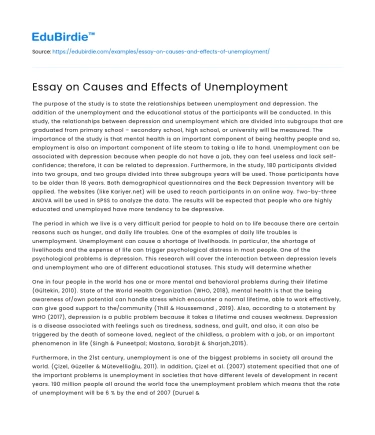Introduction
Unemployment remains a persistent and multifaceted issue that poses significant challenges to economies worldwide. It manifests as a critical indicator of economic health, influencing social stability and individual well-being. The complexity of unemployment lies in its myriad causes and far-reaching effects, which necessitate a comprehensive understanding to formulate effective policy responses. In recent years, global economic shifts, technological advancements, and demographic changes have further complicated the unemployment landscape. This essay seeks to dissect the underlying causes of unemployment, explore its socio-economic effects, and evaluate counter-arguments to provide a holistic perspective. By examining real-life case studies and drawing on credible sources, this analysis aims to illuminate the intricate dynamics of unemployment and underscore the importance of strategic interventions to mitigate its impact. This exploration begins with an analysis of the causes of unemployment, followed by an examination of its effects, setting the stage for a nuanced discussion on this enduring economic challenge.
Structural Causes of Unemployment
One of the primary causes of unemployment is structural change within economies, often driven by technological advancements. As industries evolve, the demand for certain skills diminishes while new competencies are sought after. For instance, the automation of manufacturing processes has significantly reduced the need for manual labor, a phenomenon documented by Autor (2015), who highlights the "polarization of job opportunities." This technological disruption necessitates that workers adapt through reskilling and upskilling to remain relevant in the job market. However, the transition is neither smooth nor immediate, often resulting in periods of unemployment. Additionally, globalization has shifted jobs across borders, intensifying competition and resulting in job displacement in certain sectors. The textile industry, for example, has witnessed significant job losses in developed countries as production has moved to regions with lower labor costs. This structural unemployment underscores the need for proactive labor policies that emphasize education and training to align workforce capabilities with market needs.
Save your time!
We can take care of your essay
- Proper editing and formatting
- Free revision, title page, and bibliography
- Flexible prices and money-back guarantee
Another structural factor contributing to unemployment is demographic shifts, particularly in aging populations. Countries with a significant proportion of older workers face unique challenges, as retirement transitions create gaps in the workforce. Conversely, in nations with a burgeoning youth population, such as many African countries, the challenge lies in creating sufficient employment opportunities to accommodate new entrants into the labor market. This demographic diversity requires tailored approaches to employment policy, recognizing the distinct needs of different age groups within the labor force. Moreover, rigid labor markets, characterized by inflexible employment laws and regulations, can exacerbate unemployment by discouraging employers from hiring due to the costs and risks associated with firing. As noted by Nickell (1997), such regulations can lead to a "sclerotic" labor market, where job creation is stifled, further entrenching unemployment.
Socio-Economic Effects of Unemployment
The effects of unemployment extend beyond economic dimensions, profoundly impacting social structures and individual lives. Economically, high unemployment rates lead to decreased consumer spending, as individuals without income reduce their consumption. This reduction in demand can trigger a downward economic spiral, adversely affecting businesses and potentially leading to further job losses. The economic insecurity experienced by unemployed individuals often results in increased reliance on social welfare systems, straining public resources. Additionally, the loss of income and employment can lead to a decline in living standards, exacerbating poverty levels and income inequality within societies.
Socially, unemployment can have detrimental effects on mental health and community cohesion. Studies have shown a correlation between unemployment and increased levels of stress, anxiety, and depression (Paul & Moser, 2009). The psychological impact of job loss can lead to a decrease in self-esteem and a sense of purpose, affecting individuals' overall well-being. Furthermore, prolonged unemployment can erode social networks, as individuals may withdraw from community activities due to financial constraints or embarrassment. This social isolation can perpetuate a cycle of disadvantage, limiting access to job opportunities and support systems. The societal impact of unemployment is also evident in increased crime rates, as economic hardship may drive individuals towards illegal activities as a means of survival. Addressing these socio-economic effects requires comprehensive policy interventions that encompass mental health support, community engagement programs, and robust social safety nets.
Conclusion
In conclusion, unemployment is a complex phenomenon with diverse causes and profound effects, necessitating a multifaceted approach to address its challenges. Structural changes in the economy, driven by technological advancements and globalization, require adaptive strategies to equip workers with the skills needed for emerging industries. Demographic shifts further complicate the unemployment landscape, demanding targeted policies that cater to different age groups within the labor force. The socio-economic effects of unemployment underscore the importance of holistic interventions, encompassing economic, social, and psychological dimensions. While counter-arguments highlight the potential for technological advancements to create new job opportunities, the transition period remains a critical concern. Effective policy responses must balance the need for immediate support for the unemployed with long-term strategies for workforce development. As economies continue to evolve, the ongoing dialogue on unemployment must prioritize innovation, inclusivity, and resilience to build a future where employment opportunities are accessible to all.






 Stuck on your essay?
Stuck on your essay?

